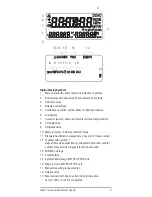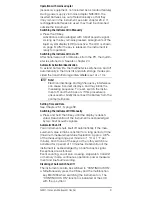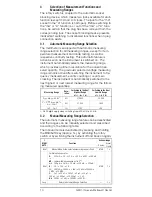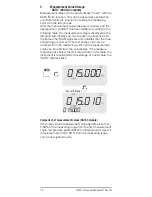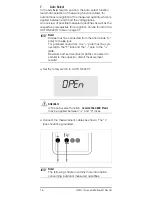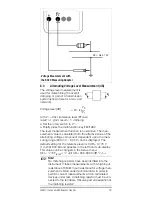
GMC-I Gossen-Metrawatt GmbH
7
GB
• Avoid working alone when taking measurements which
involve contact hazards. Be certain that a second person
is present
.
• The maximum allowable voltage between any given connector
jack (7) and earth is equal to 600 V, category III or to 300 V,
category IV.
• Be prepared for the occurrence of unexpected voltages
at devices under test (e.g. defective devices). For exam-
ple, capacitors can be dangerously charged.
• Make certain that the measurement cables are in flaw-
less condition, e.g. no damage to insulation, no interrup-
tions in cables or plugs etc.
• No measurements may be made with this instrument in
electrical circuits with corona discharge (high-voltage).
• Special care is required when measurements are made
in HF electrical circuits. Dangerous pulsating voltages
may be present.
• Measurements under moist ambient conditions are not
allowable.
• Be absolutely certain that the
measuring ranges are not
overloaded beyond their allowable capacities
. Limit val-
ues can be found in the table “Measuring Ranges” in
Chapter 25 „Characteristic Values“.
• All current ranges are equipped with fuses (Nominal volt-
age of fuse = 1000 V). The maximum allowable voltage
for the measuring current circuit (= rated voltage of the
fuse) is equal to 600 V AC/DC in the “mA” and “A”
ranges.
• In switch position AUTO SELECT,
Ω
, ,
°
C and F, the instru-
ment may only be used in power installations when the electri-
cal circuit is protected with a fuse or circuit breaker up to 20 A,
and the nominal voltage of the installation does not exceed
600 V in order to provide protection also under single-fault con-
ditions (EN 61010-1).
Measuring Categories and their Meaning per IEC 61010-1
The measurement category and the relevant maximum
rated voltage (e. g. 600 V CAT III) which are shown on the
instrument casing apply to your measuring instrument.
CAT
Definition
I
Measurements in electrical circuits not directly connected to the mains
system:
e. g. power systems in motor vehicles or aeroplanes,
batteries ...
II
Measurements in electrical circuits directly connected to the low-volt-
age system:
via plug, e.g. in households, offices, laboratories ...
III
Measurements in facility installations:
stationary consumers, distributor connections, devices
attached to a distributor
IV
Measurements at the source of low-voltage installations:
Meters, main terminal, primary overcurrent protection devices



